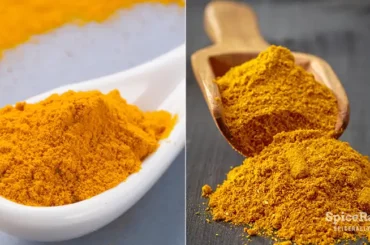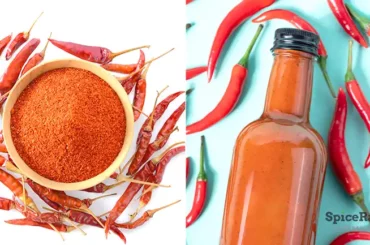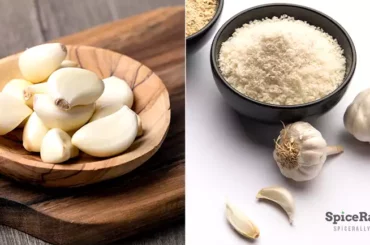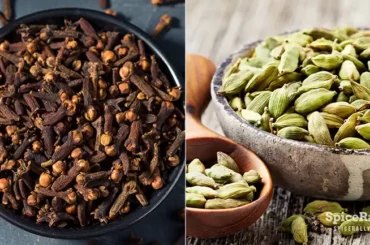Spices typically come in two primary forms when you buy them from the store: ground and whole. However, this article will share how to grind spices into different textures at home effortlessly and efficiently.
Spices can be ground in several ways and different textures. Although the ancient method calls for a mortar and pestle, this method also applies to the present day. However, there are easier and more efficient ways to grind your favorite whole spices at home. That is using a spice grinder, coffee grinder, food processor, Microplane, etc.
So, here’s a complete guide on grinding your own spices at home to come up with a fresh, quality batch to make your favorite dishes.
How To Grind Spices At Home?
Many whole spices are readily available in the store in their ground forms for the convenience of consumers. Yet many prefer grinding their favorite spices at home for many obvious reasons. Referring to the term “grinding” means several things in terms of spices.
You can either pound, dry grind, or wet grind them to get the expected results. The way of grinding depends on the spice and the purpose of usage. While fresh spices usually count in for pounding or wet grinding, dry whole spices are typically dry ground or sometimes pounded.
What Are The Different Grinding Textures Of Spices?
The texture of the spice you wish to grind solely depends on your preference. Accordingly, the textures of most dry spices can be categorized as coarse and fine. In addition to this, some selected spices like garlic and ginger even come out as granulated and minced. In the meantime, dried red chiles are often ground as “crushed chile flakes.”

Granulated and minced spices often have larger particles than coarse or powdered forms. While crushed chile flakes are also completely different in consistency when compared to powdered chiles, although they come from the same spice! Moreover, fresh spices shape a texture of none of the above, which is a paste.
This calls for either pounding or wet grinding. Wet grinding usually requires another additive (a liquid like water or oil) to facilitate the grinding process. We don’t usually see this technique when grinding whole dry spices, which typically come out as dry flakes, granules, or powder.
How Can We Grind Spices Into Different Textures?
There are several convenient ways of grinding spices into different textures at home. You can use either machines or tools to do this, depending on your preference.
However, paying close attention to your machine or tool is essential since some spices require specific machines or devices to give the expected texture. Generally, the texture depends on the potency of the blade, effort, pressure, and mostly the time you put on a specific spice to grind it.
While some tools and machines can give you a fine powdery spice with a little effort and time, some will demand more pressure and exertion. At the same time, you can adjust the texture by controlling and keeping in check the time you use the particular spice.
01- Using The Coffee Grinder
The first, most convenient, and accessible option is using the coffee grinder that most of you might probably have at home. The jar and the blade, from standard quality to high-quality coffee grinders, are powerful enough to crush the hard coffee beans.
Thus, you can count on this appliance to grind anything from soft to hard whole dry spices. But when considering a nutty spice nutmeg, you may need a more powerful coffee grinder than a regular one.
Pro Tip – Most of you might be thinking about what will happen to your coffee grinder after grinding robust spices. In fact, your coffee grinder could be left with a spicy aftertaste which can ruin the original, pure taste of your precious coffee.
But this has a solution!
You can try grinding some raw rice in your coffee grinder after going with every batch of spices. Put some uncooked rice into your coffee grinder, pulverize it for a few minutes until it becomes a powder, and remove and discard the content.
Then, you can clean the jar and blade with a wet towel and water. Keep doing this each time you need to use your coffee grinder to grind spices.
02- Spice Grinders
Investing in a good-quality spice grinder is an excellent decision if you plan on grinding your spices often at home. These machines have more effective motors than small coffee grinders; some models have removable grinding receptacles with lids.
Yet, the best models have glass and metal pieces in the grinding bowl since cloves and other potent spices contain volatile oils that can fade plastic. If you’re ready to invest in a spice grinder, ensure to purchase one that will suit your needs.
For example, most spice grinders come as nut grinders which will also help out with hard spices like nutmeg. Meanwhile, some are not ideal for lightweight spices. Therefore, check with the manufacturer and buy the device that will be effective in every aspect, especially if you’re a beginner.
03- How To Grind Spices Using The Food Processor?
If you have the “grind” setting on your appliance, you can grind your spices easily in the food processor. If not, a medium setting also works well. Process the spices in increments of 15 to 30 seconds, depending on the size of the spice and preferred texture. Avoid using “pulse” settings for more effective grinding.
04- Blender For Wet Grinding
Blender is the ideal appliance for wet grinding that will save you a lot of time and effort. You can use the blender to grind fresh spices like garlic, ginger, turmeric, galangal, or soft spices like chile peppers, But putting whole, hard spices like black pepper, nutmeg, cloves, etc. might harm the blade and jar of your blender.
What Kind Of Kitchen Tools Can Help You To Grind Your Spices?
Using some basic kitchen tools, you can get a great batch of ground spices to spark up your dishes. So, here we go!
01- Mortar and Pestle
Used since ancient times, mortar and pestle is one of the most common and popular kitchen tools associated with spices and herbs. We can see this asset in many households as a contemporary tool that will help you out with pounding, wet, and also dry grinding.
Since the procedure goes manually, the control is all yours, and you can always get the expected consistency. But we must remind you that grinding your spices using this equipment can take a little more time and effort than using an electric machine. This equipment is ideal for soft spices while you have to toast the dry spices before grinding to facilitate the process.
However, crushing releases a fuller content of essential oils and flavors than an electric grinder’s chopping action. And with no nooks and crannies to entrap food particles, mortars, and pestles are relatively easy to clean.
02- Microplane Graters
A Microplane grater is much sleeker and smaller than its big box grater cousin, making it versatile enough to fit into your kitchen cabinet. It is also known as the rasp grater and comes in several sizes. While you can use it to mince garlic and ginger, you could also use it to get freshly shaved nutmeg. In fact, Microplane is the most convenient way to grind nutmeg to get its best flavor, potency, and aroma.
03- The Wonder Of Pepper Mills!
This handy little companion is a must-have and, indeed, the best way to get freshly ground black pepper. Nothing can beat the flavor and quality of freshly ground black pepper, not even the pre-ground pepper powder!
However, the pepper mill is not ideal if you wish to have a very fine powdery texture since this device gives a coarse consistency. The most interesting thing is you can also grind allspice berries, juniper berries, Szechuan peppercorns, and even coriander seeds using this versatile pepper mill.
Did You Know A Rolling Pin Works Too?
When you have nothing around, a rolling pin, along with two more everyday kitchen items, can help you grind spices. This method is excellent if you need to grind smaller amounts of spices. But for this, your spices should be nicely roasted and crunchy.
With the rolling pin, you should have a thick piece of parchment paper and a sturdy wooden cutting board. If you don’t have a rolling pin, a meat tenderizer or a cast iron skillet with a thick, wide bottom will also serve as a great alternative.
How Does It Work?
Put the spices in the space between the folded baking paper, close to the spot it was folded. Place the paper containing the spices onto the cutting board. Start by placing the preferred quantity of spices between the parchment paper and folding it into two.
Then, use a wooden rolling pin to smash where the spices are placed on the paper. Use a little pressure to make sure the spices are well-pulverized. Keep the ends of the paper pushed together with your hand to avoid the spices from leaping out.
During the pounding process, take one or two pauses to open the paper and carefully shake the spices. Now, cover the paper and continue smashing. This way, you’ll get finer and more uniform grinding of the spices. Like the mortar and pestle, you have control of the consistency when using this way as well.
Storing Your Ground Spices
Freshly ground spices are best stored right after grinding in an airtight glass spice container that is preferably dark in color to protect the spices from sunlight. Refrigeration is optional, but this can be done for long-term storage rather than for spices used regularly.
And, if you keep ground spices in a shaker, avoid shaking the jar over the heat, as moisture can seep into the container and cause clumping. When stored properly, most spices will stay fresh anywhere from one to four years.
Pro Tips And Tricks To Follow When Grinding Spices At Home…
Here are some tips and tricks to get the best-expected quality, flavor, aroma, and potency from the spices you grind at home!
- Always use new spices as much as possible. Avoid using aged ingredients, as they will not give the expected results.
- If you always prefer a fine powder, keep a separate fine mesh sieve dedicated to spices. You can run the content through the sieve, regrind any large clumps, and add it to the ground content.
- Make sure all the tools and machines you use throughout the process are clean and dry.
- Take time to wash and dry-clean the items after every batch of spice if you are following up with different spices. For example, you should not clean the tools thoroughly when you grind dried chile peppers and black pepper before following with something like cinnamon, nutmeg, mace, etc.
- Make sure to wear gloves, a face mask, an apron, and goggles if you’re sensitive to spices. Also, do the grinding in a well-ventilated place.
- Wash your hands thoroughly after you’re done with grinding. And clean the machines, tools, and utensils with dish soap before using them for another chore.
Why Is it Important to Toast The Spices Before Grinding?
Toasting spices will emphasize the flavor profile, creating a fuller profundity of flavor and helping bring out the natural fragrances of the essential oils in the spices. Toast your spices just before using them to savor the boosted concentration of flavors better.
Why Do You Want To Grind Spices At Home?
Spices contain two types of oils: non-volatile oils that provide the scent and volatile oils that give the flavor of the spice. Non-volatile and volatile oils naturally break down over time, making the spices less powerful. They are also released when whole spices, like black pepper, are ground.
This is why the aroma and taste of freshly ground spices are much more intense than those of pre-ground spices. Therefore, it is really worth using freshly ground spices whenever possible to get more flavor. However, it is essential to remember that whole spices also last much longer in your pantry than pre-ground ones.
Freshly Ground Spices Can Always Make Premium-quality Dishes!
Grinding spices when needed is an effortless and excellent way to ramp up the flavor, quality, and fragrance of your dishes. You can grind them fresh, separately for each recipe, or in bulks, and store them for future use.
However, you should be conscious of how long your ground spices have been lying in the pantry because their flavor and quality depend on the oils they contain, which can fall through over time. Therefore, the best option is always to grind them right before use.




